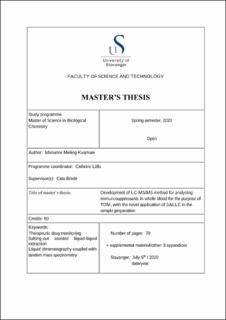| dc.description.abstract | The laboratory for Medical Biochemistry at Stavanger University Hospital (SUS) needed a new method for analysing tacrolimus, sirolimus, everolimus and cyclosporin A. A method was developed using the analytical principles of liquid chromatography coupled with tandem mass spectrometry (LC-MS/MS), with a sample preparation based on the principles of salting-out assisted liquid-liquid extraction (SALLE). LC-MS/MS was preferred because of the potential efficiency and selectivity. SALLE was predicted to be a good sample preparation method due to the extraction solvent’s compatibility with the mobile phase of LC-MS/MS.
The instrumental method was first programmed by tuning the mass spectrometer for detection of the most prominent molecular ion adducts and MRM-transitions with the strongest signals. Then the liquid chromatographic (LC) separation was optimised by finding the best elution solvent and elution gradient. The tuning of the mass spectrometer was done by injecting pure solutions of the analytes and their internal standards to eliminate interference. Molecular ions with Na+ adducts were the most prevalent for tacrolimus, sirolimus, and everolimus. Cyclosporin A, however, had molecular ions with both Na+ and H+ adducts. Methanol in the mobile phase procured the best LC-separation and highest signal intensity of the three solvents (methanol, acetonitrile, and acetone).
Optimisation experiments were performed with a saturated NaCl solution (5 M), and several water miscible solvents in various concentrations, as well as one experiment with PPT, to compare the effects. Solvents included in the experiments were methanol, acetonitrile, acetone, tetrahydrofuran. The final optimised sample preparation method was SALLE with NaCl (5 M, 100 μL) and 12.5 % (v/v) methanol in acetonitrile.
The most important performance characteristics measured for the new method were limit of detection (LOD), limit of quantification (LOQ), relative spike recovery (%), repeatability and reproducibility. The LOD and LOQ for each analyte was: tacrolimus (0.1 ng/mL, 0.3 ng/mL), sirolimus (0.2 ng/mL, 0.5 g/mL), everolimus (0.03 ng/mL, 0.1 ng/mL), and cyclosporin A (3.5 ng/mL, 6.4 ng/mL). The relative spike recovery was in the range between 100 - 108 % (± 1 – ± 7), and the repeatability across all analytes and quality control levels was acceptable with a CV in the range of 2.0 – 5.6 %. The reproducibility CV across the different quality control levels was somewhat high and varied significantly between the analytes. The range for the reproducibility CV for each analyte was: tacrolimus (5.6 – 9.3 %), sirolimus (11.5 – 14.0 %), everolimus (8.0 – 13.4 %), and cyclosporin A (6.2 – 12.3 %). The range of the reproducibility CV was however lower when only including the results from one specific lot of calibration standards. The range of the reproducibility CV for each analyte was then: tacrolimus (2.1 – 4.9 %), sirolimus (4.7 – 6.8 %), everolimus (2.4 – 6.0 %), and cyclosporin A (3.8 – 6.4 %).
The new method was also compared separately to both an established immunoassay-based method used in the laboratory for Medical Biochemistry at Stavanger University Hospital, and an established LC-MS/MS method used in the Department of Pharmacology at Oslo University Hospital (OUS). The relative mean difference (%) with upper and lower limit of agreement (LoA) was calculated for both method comparisons by plotting the results into a Bland-Altman plot. The new method had a relative mean difference of -28 % for tacrolimus and -20 % for cyclosporin A compared to the immunoassay-based method. This meant there was a poor correlation between the two methods, and the new method measured the concentration to be much lower than in the immunoassay-based method. When the new method was compared to the LC-MS/MS method, the correlation for tacrolimus and cyclosporin A was much better, with a mean relative difference of 10 % for tacrolimus and 2 % for cyclosporin A. The correlation for sirolimus and everolimus was however not as good, with a mean relative difference of -12 % for sirolimus and -17 % for everolimus.
The work done in conjunction with this thesis gave the laboratory for Medical Biochemistry a new method for analysing immunosuppressant in blood with a unique sample preparation applying the extraction principles of SALLE, which improved the sensitivity of the analysis, reduced the ion suppression, and increased the efficiency of the analytical process. | en_US |
